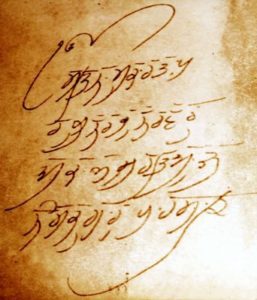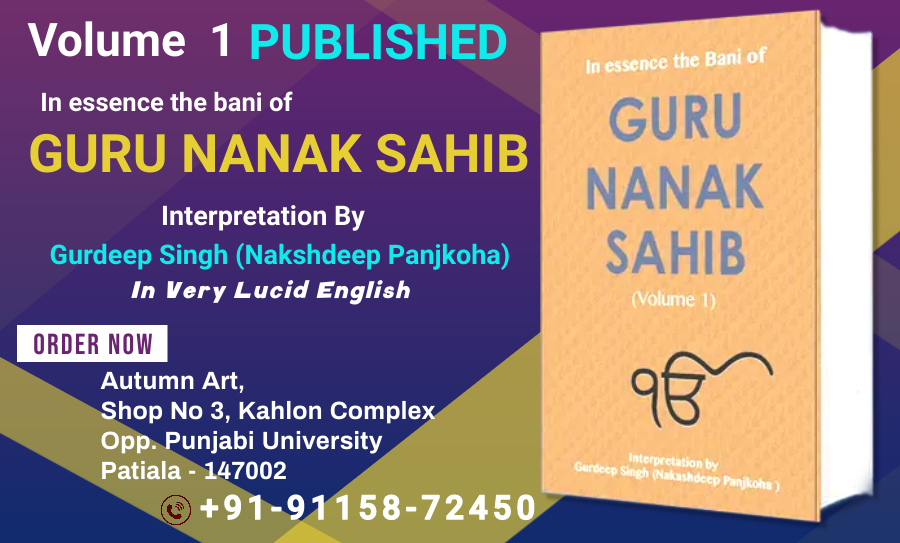
Regardless the status we enjoy, one thing is very clear that whatever we advocate today openly, we may find it incorrect as we learn later on about it further in depth. Such dilemma might have happened to those, who harbor open mind to new searches and experiments. In Sikh circles, I have noticed that many groups are stuck to their agendas so blindly that they don’t budge in regardless how strongly their beliefs are proven wrong; this is a tragedy of living in ignorance that blurs any apparent logic. This factual cultural inclination is found in all groups everywhere in the world; unfortunately, many of the Sikhs are prone to obstinacy that is deeply rooted in their conceit that embraces ignorance over sanity for its satisfaction. There are many issues, which are debated with reasoning in the Sikh circles; nonetheless, still some debaters never change their stance even if their self defensive behavior appears very infantile, because, being befogged by conceit, learning through dialogue doesn’t fit in their mind-set. Indulging in their debates once, I have learned that it is futile to convince a person, who has taken a stand and determined not to listen whatever logic is presented. Understanding the Gurbani is not that much difficult as it has been said by many scholars. Because the Gurbani is in poetic form, its meanings are often taken very differently depending upon a person and his or her affiliation to a chosen school regardless the fact that it has been interpreted and reinterpreted throughout Sri Guru Granth Sahib. Why even we need an endorsement of a school when we see the Gurbani already interpreted by its authors? I wonder how the Guru’s message can be different! Unfortunately, the truth is advocated otherwise. I have read various commentaries on Japji by many scholars, but I have found a profound and convincing ideology the Guru has expressed in it only through studying the bani of Sri Guru Granth Sahib in its entirety. If one hasn’t studied Sri Guru Granth Sahib completely, one has no right to give commentary on Japji, because the contents of Japji has been widely elaborated by First Nanak, Second Nanak, Third Nanak, Fourth Nanak, Fifth Nanak and Ninth Nanak. Keeping this in mind, I have prepared a commentary on Japji, hoping it will help the Gurbani lovers; however, having said that, I humbly refuse to make any sophistry claim about its being the best one.
Before I start the Guru’s discourse, I request you that in his Bani, he is very well aware that the world we all are put in is real, beautiful, fascinating and sometimes ugly; however, thorns of miseries, pains and tragedies are also embedded with it just as a big rose plant loaded with flowers also has its thorns well alive; if one embraces it to enjoy its fragrance without being careful, one will get hurt certainly with its thorns, and in the same way, the world, being beautiful and fascinating, is also loaded with thorn-like pains and miseries; therefore, dealing with it, one needs to be careful. A wise person just enjoys rose-plant beauty by standing close to it ignoring his or her urge to embrace it; Akalpurakh’s lover simply remains detached to the beautiful and ugly world while living as a witness right in it by not involving in its attractions; however, this doesn’t mean ignoring familial and moral duties. In Japji, first the Guru introduces to us our all-pervading Creator, who is premating everywhere and everything. The entire introduction, also called “Mool Mantra “by some people, is in prose though every word used in it has a poetic gloss.
Many promoters of Hindu scriptures claim that what Guru Nanak ji says about the Creator is already in the old Sanskrit scriptures; nonetheless, they fail to understand that the ultimate Truth was never new or will be ever old, and Guru Nanak ji has elaborated the Creator as per his own experience, and he hasn’t considered worthy of mentioning their scripture, Gita, they refer to so proudly while commenting on his bani. In their scriptures, if they find glimpses of the Creator the Guru expresses, they should also understand that he has openly declared that anyone can experience the Creator through a Guru, who has experienced Him, the ultimate Truth. They should also realize that if their scriptures have references of the same Creator, they are also loaded with the duality concepts that have buried the truth about Him under so many add-ons. Obviously their commenting this way on Sri Guru Nanak ji is nothing but their feeling of envy towards his audacious campaign of bringing spiritual knowledge to common people.
You will notice as you go through “Japji”, the Guru’s focus remains fixed on the Creator while elaborating on various mythological characters, make up religious traditions and coined up definitions of spirituality established by business minded people, who actually created impediments to a true spiritual realm; he keeps repudiating all of them by introducing his own spiritual experience of the Creator; consequently, his true followers become able to be free of dogmatic bonds in the names of various religions though he never criticizes any religion particularly. Truly he is not seen interested in that instead he is found involved in unbinding humans’ bonds created by various groups to their personal interest and advantage. Unfortunately and ironically, today in the name of his path, many bonds are created contrary to his mission of enabling the mortals to be free like a flying bird in search of their beloved “Ekankar”.
Introduction:
Page 1
ੴ ਸਤਿ ਨਾਮੁ ਕਰਤਾ ਪੁਰਖੁ
ਨਿਰਭਉ ਨਿਰਵੈਰੁ ਅਕਾਲ ਮੂਰਤਿ ਅਜੂਨੀ ਸੈਭੰ ਗੁਰ ਪ੍ਰਸਾਦਿ ॥
Ik-oaʼnkār saṯ nām karṯā purakẖ
nirbẖa-o nirvair akāl mūraṯ ajūnī saibẖaʼn gur parsāḏ.
In essence: There is only one all pervading Creator, whose name is a reality. He is the Creator, who is beyond fear and animosity. His form is beyond death and birth. He is from Himself (self illumined); He is known through the Guru’s blessings.
It will be useful to understand the concept of the Creator explained by First Nanak if we understand “ੴ”; it will also become easy to understand toward whom the Guru leads his followers. First, ੧ is a symbol of number one; First Nanak himself on 57, SGGS, does its usage and description:
ਨਾਨਕ ਏਕੋ ਰਵਿ ਰਹਿਆ ਦੂਜਾ ਅਵਰੁ ਨ ਕੋਇ ॥੮॥੬॥
Nānak eko rav rahi-ā ḏūjā avar na ko-e. ||8||6||
{SGGS–57}
In essence: Oh Nanak! There is none but only one (Akalpurakh), who is pervading all over.
And, on 350, SGGS, he says:
ਸਾਹਿਬੁ ਮੇਰਾ ਏਕੋ ਹੈ ॥
ਏਕੋ ਹੈ ਭਾਈ ਏਕੋ ਹੈ ॥੧॥ ਰਹਾਉ ॥
Sāhib merā eko hai.
Ėko hai bẖā-ī eko hai. ||1|| rahā-o.
{SGGS–350}
In essence: My Master is but one. Oh brother! My Master is one only. Pause.
In the following verses, the virtues of “the only one Creator” are expressed as the Guru defines Him as a unique entity on 9, SGGS:
ਨਾ ਓਹੁ ਮਰੈ ਨ ਹੋਵੈ ਸੋਗੁ ॥ ਦੇਦਾ ਰਹੈ ਨ ਚੂਕੈ ਭੋਗੁ ॥
ਗੁਣੁ ਏਹੋ ਹੋਰੁ ਨਾਹੀ ਕੋਇ ॥ ਨਾ ਕੋ ਹੋਆ ਨਾ ਕੋ ਹੋਇ ॥੩॥
Nā oh marai na hovai sog. Ḏeḏā rahai na cẖūkai bẖog.
Guṇ eho hor nāhī ko-e. Nā ko ho-ā nā ko ho-e. ||3||
{SGGS–9}
In essence: Ekankar doesn’t die; therefore, there is no mourning for Him (all people die and they are mourned); He keeps giving and the prevision of “His giving away” doesn’t run out. This is a quality of Ekankar that there is none like Him; neither like Him existed before, nor would be ever.
This way, the Guru stresses on the Creator’s being only one; therefore, ੴis one word all together.
The second part of “ੴ” is “ਓ” = ਓਅੰ; Dr. Sahib Singh writes: It is a word of Sanskrit used in three contexts:
a). To be written in the beginning of a sacred scripture.
b). To say “yes” in response to an order.
c). It is used for the Creator.
Bhai Gurdas in Vaar 3, stanza 15, describes for what “ਓ” stands, and that is “Onkar”; he also says that by using “੧ Eka/one” (“not ikk”) with ਓ, the Guru makes it “Ekankar.” Basically, it is Onkar, who creates and destroys (Dakhni Onkar, 929, SGGS). It is also the Guru’s rejection of the three entities, established in the Hindu scriptures, having different jobs like one creates, the second one kills and the third one provides sustenance to the created ones, it is on 7, SGGS.
ਏਕਾ ਮਾਈ ਜੁਗਤਿ ਵਿਆਈ ਤਿਨਿ ਚੇਲੇ ਪਰਵਾਣੁ ॥
ਇਕੁ ਸੰਸਾਰੀ ਇਕੁ ਭੰਡਾਰੀ ਇਕੁ ਲਾਏ ਦੀਬਾਣੁ ॥
Ėkā mā-ī jugaṯ vi-ā-ī ṯin cẖele parvāṇ.
Ik sansārī ik bẖandārī ik lā-e ḏībāṇ.
{SGGS–7}
In essence: From Maya have come the three accepted (by some) disciples (obedient sons of Maya) into existence; (It is believed) one of them is house-holder (as a family man who makes babies), the second one of them takes care of the creation with the stores he has and the third one of them sets up the court (to decide who should die).
Interestingly, the Guru rejects all of them by acknowledging only Ekankar as the sole doer of everything by saying that the people just don’t see Him though He does (7, SGGS).
It is very important to know that Bhagat Kabir also refers the Creator as “Onkar” in Bavan Akhri, 340, SGGS; however, by using ੧ and ਓ together, First Nanak names “Onkar” as “Ekankar”; as stated above, Bhai Gurdas in Vaar, stanza 15, pronounces ੧ as “Eka” not Ikk. In Sri Guru Granth Sahib I haven’t found “Ikk Onkaar” but “Ekankaar”. Many Sikhs pronounce “ੴ” as “ikk onkar” also; Ekankar is referred in SGGS for the all pervading Creator. Please also keep in mind that when “one” (ਇਕੁ Ikk) is actually used with Ekankar, then the Gurmukhi–lipi–ounkud of the last letter is taken away; examples:
On 189, SGGS, “ਇਕੁ /IKK” is not used before Ekankar and ounkud is used with its last letter:
ਦ੍ਰਿਸਟਿ ਆਵੈ ਸਭੁ ਏਕੰਕਾਰੁ ॥੨॥
Ḏarisat āvai sabẖ ekankār. ||2||
{SGGS–189}
Means: Everywhere Ekankar is seen.
Now see on 276, SGGS, ਇਕੁ /IKK is used before Ekankar, but Ounkud is taken away.
ਸਦਾ ਸਦਾ ਇਕੁ ਏਕੰਕਾਰ ॥
Saḏā saḏā ik ekankār.
{SGGS–276}
Means: Forever is only (one) Ekankar.
Above ਇਕੁ is used as an adjective not noun. On 736, SGGS, all boundaries of oneness of the Creator are expressed by using Ekankar without Ounkud. Here is Fifth Nanak:
ਭ੍ਰਮਨ ਛੂਟੇ ਤੇ ਏਕੰਕਾਰ ॥੩॥
Bharam chhootay tay aikankaar. ||3||
{SGGS–736}
Means: When one’s doubt is eliminated, one sees only Ekankar.
Obviously, First Nanak expresses oneness of the Creator with “ੴ” by rejecting the prevailed and frequently used word “OM”; therefore, relating Sri Guru Nanak ji to Hinduism is a fallacy and a delusional intent as he was well aware that “OM” was divided into many powers and those powers were not only named separately but dubbed as “revered entities”. In this context, the Guru rejects dividing “Ekanakar” into various powers, because He is “Kartapurakh/ ਕਰਤਾ ਪੁਰਖੁ” (Active with all powers).
ਸਤਿ: Means reality with existence. It is also expressed by using “ਸਚੁ “ which means “eternal”, but the eternity of Ekankar is expressed through the words “ਅਕਾਲ ਮੂਰਤਿ /Akāl Mūraṯ” and the slok that follows “Jap”. Here it expresses the reality of the Creator’s existence.
ਨਾਮੁ /Naam/name is not only used for the name of the Creator but also for the Creator; in other words ਨਾਮ is used as Ekankar, or Akalpurakh, Har, Prabh and His other names. I have tried not to use “the” article with “ਨਾਮ /Naam”, wherever it is used for Akalpurakh. Examples: 284, SGGS:
ਨਾਮ ਕੇ ਧਾਰੇ ਸਗਲੇ ਜੰਤ ॥
ਨਾਮ ਕੇ ਧਾਰੇ ਖੰਡ ਬ੍ਰਹਮੰਡ ॥
Nām ke ḏẖāre sagle janṯ.
Nām ke ḏẖāre kẖand barahmand.
{SGGS–284}
In essence: Akalpurakh (ਨਾਮ) has established the lives. Akalpurakh has established the earth and the solar systems.
246, SGGS, ਨਾਮ / Naam is used for Akalpurakh and His name as well:
ਨਾਮੇ ਉਪਜੈ ਨਾਮੇ ਬਿਨਸੈ ਨਾਮੇ ਸਚਿ ਸਮਾਏ ॥
Nāme upjai nāme binsai nāme sacẖ samā-e.
{SGGS–246}
In essence: From “Ekankar” we emanate; we will perish into “Ekankar”; through ਨਾਮ / His name, we get absorbed in Ekankar.
Besides “ਨਾਮ / Naam”, “ਨਾਉ / naaon” or “ਨਾਵੈ /naavain” also used in the same manner; examples on 19, SGGS:
ਤਨ ਸੂਚਾ ਸੋ ਆਖੀਐ ਜਿਸੁ ਮਹਿ ਸਾਚਾ ਨਾਉ ॥
Ŧan sūcẖā so ākẖī-ai jis mėh sācẖā nā-o.
{SGGS–19}
In essence: Pure is that person (body) in whom dwells the name of the eternal Creator. And on 27, SGGS:
ਮਨਮੁਖ ਗੁਣ ਤੈ ਬਾਹਰੇ ਬਿਨੁ ਨਾਵੈ ਮਰਦੇ ਝੂਰਿ ॥੨॥
Manmukẖ guṇ ṯai bāhre bin nāvai marḏe jẖūr. ||2||
{SGGS–27}
In essence: The mind-slaves die in frustration without His name and virtues.
Very clearly, the Guru advises his followers to utter ਸਤਿਨਾਮੁ repeatedly, for an example see on 670, SGGS:
ਜਪਿ ਮਨ ਸਤਿਨਾਮੁ ਸਦਾ ਸਤਿਨਾਮੁ ॥
Jap man saṯ nām saḏā saṯ nām.
{SGGS–670}
In essence: Oh mind! Utter Satnaam always repeatedly.
On 1083, SGGS, Fifth Guru deems ਸਤਿਨਾਮੁ as the primal name compared to His names given as per His power of actions:
ਕਿਰਤਮ ਨਾਮ ਕਥੇ ਤੇਰੇ ਜਿਹਬਾ ॥ ਸਤਿ ਨਾਮੁ ਤੇਰਾ ਪਰਾ ਪੂਰਬਲਾ ॥
Kirṯam nām kathe ṯere jihbā. Saṯ nām ṯerā parā pūrbalā.
{SGGS–1083}
In essence: My tongue utters your given names (as per your acts/virtues), but “Satnaam” is your primal name.
Obviously, “Satnaam” should also be taken as Ekankar’s name. When the Guru talks about obtaining “ਨਾਮ / His name”, it appears he talks about recognizing the Creator’s presence/light within.
ਕਰਤਾ ਪੁਰਖੁ: Usually “Purakh” commonly taken as a man (masculine gender); however, its usage differs in various contexts; it is used for a special Guru and also for a common man (without gender: as we use a man as a human being). Pur +akh becomes Purakh (Sanskrit). Pur means something, a body or a realm or a space; kh means to be in. As a soul is in a man (here man is taken as beyond gender); therefore, Purakh is taken as a man (beyond gender), but it has become common with masculine gender. In the Gurbani, it is used for the Creator, who permeates His creation. The word, “ਕਰਤਾ” expresses the power of creating. Together “ਕਰਤਾਪੁਰਖੁ” means the active Creator, who permeates all. The Guru rejects Abrahamic concept of the Creator” according to which, He is separate from His creation” by using ਪੁਰਖੁ with ਕਰਤਾ. Obviously Purakh is used to express the Creator’s presence in the Creation. Fourth Nanak describes “ਕਰਤਾ ਪੁਰਖੁ” beautifully on 11, SGGS:
ਤੂੰ ਆਦਿ ਪੁਰਖੁ ਅਪਰੰਪਰੁ ਕਰਤਾ ਜੀ ਤੁਧੁ ਜੇਵਡੁ ਅਵਰੁ ਨ ਕੋਈ ॥
ਤੂੰ ਜੁਗੁ ਜੁਗੁ ਏਕੋ ਸਦਾ ਸਦਾ ਤੂੰ ਏਕੋ ਜੀ ਤੂੰ ਨਿਹਚਲੁ ਕਰਤਾ ਸੋਈ ॥
Ŧūʼn āḏ purakẖ aprampar karṯā jī ṯuḏẖ jevad avar na ko-ī.
Ŧūʼn jug jug eko saḏā saḏā ṯūʼn eko jī ṯūʼn nihcẖal karṯā so-ī.
{SGGS–11}
In essence: Oh Akalpurakh! You are the primal being; you are the all pervading and infinite Creator. None is other one, who is equal to you. Only you have been here throughout all ages; you are the same eternal Creator.
ਨਿਰਭਉ: ਨਿਰ means without ਭਉ means fear. It is a virtue of the all-pervading Creator to be beyond fear. Why should the Creator fear from anyone or anything when He is the Creator of all? Besides, a power that is present in all and everywhere is already above such emotions. The Guru also addresses Ekankar as ਨਿਰਭਉ; see on 12, SGGS:
ਤੁਮ ਗਾਵਹੁ ਮੇਰੇ ਨਿਰਭਉ ਕਾ ਸੋਹਿਲਾ ॥
ਹਉ ਵਾਰੀ ਜਿਤੁ ਸੋਹਿਲੈ ਸਦਾ ਸੁਖੁ ਹੋਇ ॥੧॥ ਰਹਾਉ ॥
Ŧum gāvhu mere nirbẖa-o kā sohilā.
Ha-o vārī jiṯ sohilai saḏā sukẖ ho-e. ||1|| rahā-o.
{SGGS–12}
In essence: (Oh friends) you sing a song praising my Fearless (Ekankar); I sacrifice to that song of His praise, which brings ever peace. Pause.
ਨਿਰਵੈਰੁ: ਨਿਰ means without, ਵੈਰੁ means animosity. Like ਨਿਰਭਉ, the word ਨਿਰਵੈਰੁ is also about emotional feeling, but the Creator is beyond human feelings; in other words, He doesn’t feel or act individually as a human being. Why the Creator should harbor any feeling like animosity or fear? The Guru continues advising his followers to acquire these virtues of the Creator expressed in Sri Guru Granth Sahib.
ਅਕਾਲ ਮੂਰਤਿ: “ਅਕਾਲ” means beyond death, because “ਕਾਲ” means death or end, and ਅ means not; with it the Guru uses the word ਮੂਰਤਿ to express the existence of the Creator. When we go through Sri Guru Granth Sahib, it becomes crystal clear that the Guru also calls the Creator as ਸਰਗੁਣੁ with attributes and ਨਿਰਗੁਣ without attributes; therefore, it is stressed that the existence of the Creator is a reality, and His existence is beyond end or destruction.
ਅਜੂਨੀ: Means beyond birth; whatever comes into birth remains subject to death; therefore, being “ਅਕਾਲ” the Creator doesn’t come into an existence individually. Wherever in the Gurbani, it is stated that there is no difference between the Creator and His true devotees, we should not take its literal meaning; for example, look at the following verses on 397, SGGS.
ਆਸਾ ਮਹਲਾ ੫ ॥
ਜਿਨ੍ਹ੍ਹਾ ਨ ਵਿਸਰੈ ਨਾਮੁ ਸੇ ਕਿਨੇਹਿਆ ॥
ਭੇਦੁ ਨ ਜਾਣਹੁ ਮੂਲਿ ਸਾਂਈ ਜੇਹਿਆ ॥੧॥
Āsā mėhlā 5.
Jinĥā na visrai nām se kinehi-ā.
Bẖeḏ na jāṇhu mūl sāʼn-ī jehi-ā. ||1||
{SGGS–397}
Raag Asa, the bani of fifth Nanak.
In essence: Like what are those persons, who never forget Ekankar’s name? (Answer) Do not see any difference between them and the Master, Ekankar; they are just like Him.
His devotees are Ekankar’s ਸਰਗੁਣ form perfectly with attributes, but He is also ਨਿਰਗੁਣੁ without attributes. Through such verses, the Guru expresses the sublime status of the enlightened ones, who become one with the Creator by acquiring His virtues like to be immaculate and beyond fear and animosity. While reading such verses, we should not disobey the Guru, who says that the Creator doesn’t take birth or die.
ਸੈਭੰ: Means the Creator is from Himself (self illumined); in other words, He Himself is the source of His existence. This word also gives a subtle meaning of the verse below in “Jap” stanza, 4:
ਜੇਤਾ ਕੀਤਾ ਤੇਤਾ ਨਾਉ ॥ ਵਿਣੁ ਨਾਵੈ ਨਾਹੀ ਕੋ ਥਾਉ ॥
Jeṯā kīṯā ṯeṯā nā-o. viṇ nāvai nāhī ko thā-o.
{SGGS–4}
In essence: There is not a place without Ekankar (name); all what Ekankar has created is His name (He is everything.).
ਗੁਰ ਪ੍ਰਸਾਦਿ: Bhai Veer Singh ji describes ਗੁਰ in Santhya Sri Guru Granth Sahib, Page 31; he says: ਗੁਰ is a compound as Rara (r) is free from any vowel; therefore, its meaning is “the Guru’s. And, ਪ੍ਰਸਾਦਿ means happiness or blessings. Here it is taken as blessings; on 923, SGGS, its context is made clear:
ਪਰਸਾਦਿ ਨਾਨਕ ਗੁਰੂ ਅੰਗਦ ਪਰਮ ਪਦਵੀ ਪਾਵਹੇ ॥
Parsāḏ Nānak gurū angaḏ param paḏvī pāvhe.
{SGGS–923}
In essence: With the blessings of Guru Nanak, Guru Angad has obtained the supreme status.
And on 905, SGGS:
ਜਿਸੁ ਗੁਰ ਪਰਸਾਦੀ ਨਾਮੁ ਅਧਾਰੁ ॥ ਕੋਟਿ ਮਧੇ ਕੋ ਜਨੁ ਆਪਾਰੁ ॥੭॥
Jis gur parsādī nām aḏẖār. Kot maḏẖe ko jan āpār. ||7||
{SGGS–905}
In essence: Among millions a rare person obtains the support of Ekankar’s name with the Guru’s blessings.
Some persons, influenced by Sanskrit grammar, take ਗੁਰ as plural and come up with their own meanings; I tried to see if they are correct, but unfortunately, in Sri Guru Granth Sahib, no support is found for their claims. The Guru also uses another word “Peer”, for “Gur”; please see on 1257, SGGS: ਨਾਨਕ ਕਰਮੁ ਹੋਵੈ ਜਪੀਐ ਕਰਿ ਗੁਰੁ ਪੀਰੁ ॥ Nānak karam hovai japī-ai kar gur pīr. Oh Nanak! If one has Prabh’s grace, one meditates on Him by adopting a Guru or a Peer (religious teacher).
So ਗੁਰਪ੍ਰਸਾਦਿ means: the Creator already described is known through the Guru’s blessings.
This is the way the Guru has introduced to us our Creator. After naming the Creator as ੴ Ekankar and expressing His oneness, the Guru qualifies Him with His unique virtues in a nutshell; throughout the bani “Japji”, the description of Ekankar continues through the words like ordinance, His power to permeate His creation, His power of giving sustenance to all the lives, His power in His praise and His power over the entire nature and beyond. By repeatedly referring to Mool Mantra in short or in full version, the Guru doesn’t let his follower misunderstand Him with any misleading statement about the Creator. Those people, who claim that the Mool Mantra is up to the first slok of Japji, obviously are disobeying the Guru, who names the bani as Jap after the “Mool Mantra/Prelude-introduction”. Nowhere else in the Sri Guru Granth Sahib, their claimed form of the Mool Mantra is found or repeated. I wonder why anyone needs to make such claims! The first slok “ਆਦਿ ਸਚੁ ਜੁਗਾਦਿ ਸਚੁ ॥ ਹੈ ਭੀ ਸਚੁ ਨਾਨਕ ਹੋਸੀ ਭੀ ਸਚੁ ॥੧॥ Āḏ sacẖ jugāḏ sacẖ. Hai bẖī sacẖ Nānak hosī bẖī sacẖ. ||1||” expresses the eternity of Ekankar. Even in Sukhmani, on 285, SGGS, before ashtpadee number 17, it is indeed termed as a Slok. If it were a part of the “Mool Mantra”, the Guru would not split it and term one part of it as “a slok”.
In wider application: First, the Guru describes how only one Creator is behind every life or thing we see or beyond our seeing; second, he qualifies the Creator through unique qualities like His being beyond birth or death and being self-illuminating. Through other quality like beyond animosity, the Guru rejects the views of those people, who claimed to be chosen by Him. A life has a basic instinct to survive, and the fear comes out of this surviving instinct. The Guru advises the followers not to treat the Creator as a human, because human instincts are not His traits. To be one with the fearless, one needs to be fearless and unbiased like Him. A human is His creation, but He is beyond His creation. He is in the galaxies and beyond; therefore, do not try to establish Him on a place or in a “being”. The Guru stresses throughout Sri Guru Granth Sahib that He can only be experienced through a Guru, who has experienced Him. Anyone who is attached to the wealth and other kinds of Maya pursuits cannot help others to experience the Creator; therefore, the Guru addresses such fake Gurus as well; see on 465, SGGS:
ਵਾਇਨਿ ਚੇਲੇ ਨਚਨਿ ਗੁਰ ॥ ਪੈਰ ਹਲਾਇਨਿ ਫੇਰਨਹ੍ਹਿ ਸਿਰ ॥
Vā-in cẖele nacẖan gur. Pair halā-in ferniĥ sir.
{SGGS–465}
In essence: The disciples play the music and the Gurus dance by moving their feet and heads.
Obviously such Gurus don’t know Ekankar and cannot help others to experience Him. Basically, Sri Guru Nanak ji asks the seekers to break away from any other entities including those who were worshiped and revered in his time. We will see him totally focused on Ekankar in his bani “Japji” as we go through it. Creating any story about any Devi or Devtas around Sri Guru Nanak’s descending Nanaks can be nothing but a conspiracy to blur the light he has given to the seekers. A Sikh should never ever forget his following verses as quoted earlier:
ਸਾਹਿਬੁ ਮੇਰਾ ਏਕੋ ਹੈ ॥ ਏਕੋ ਹੈ ਭਾਈ ਏਕੋ ਹੈ ॥੧॥ ਰਹਾਉ ॥
Sāhib merā eko hai. Ėko hai bẖā-ī eko hai. ||1|| rahā-o.
{SGGS–350}
In essence: My Master is but one. Oh brother! My Master is one only. Pause.
A true Sikh chooses the Creator over all human beings and falls in love with Him; thus the act of falling in love with Him sets a Sikh free from all bonds.
CONTINUES…….
Wishes
Gurdeep Singh





